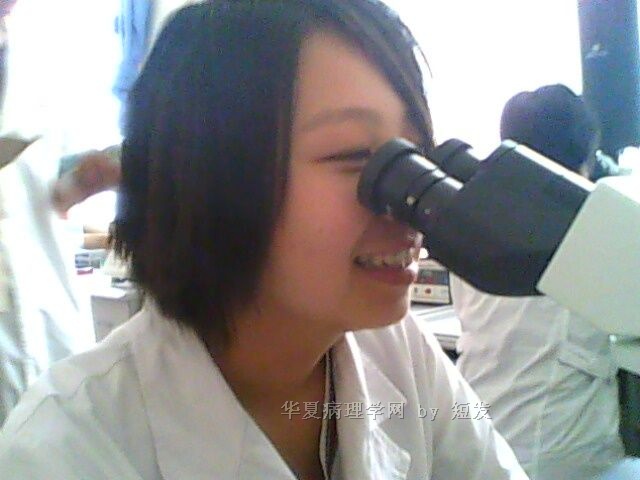| 图片: | |
|---|---|
| 名称: | |
| 描述: | |
- HPV与挖空细胞有必要的联系吗
-
本帖最后由 于 2010-06-29 09:32:00 编辑
这问题问得确实很专业和复杂;就我个人了解的一点知识做一个简单的回复;不妥之处请其他老师帮忙指出和补充。
HPV感染不一定都会出现挖空细胞;但是挖空细胞一定跟HPV感染相关。确实不同亚型的HPV有的可以引起挖空有得不能引起挖空细胞。从挖空细胞的定义来讲:挖空细胞是人类乳头瘤病毒(HPV)感染引起的相关细胞病理学改变,当然挖空细胞跟HPV感染有必然的联系。这样说您的第一问题:换成挖空细胞跟HPV感染有必然的联系;但是HPV感染不一定都会出现挖空细胞。那问题产生了,为什么细胞学或组织学看到了典型的挖空细胞,而我们做的HPV检测是阴性?主要原因有以下几条:1、检测结果假阴性,2、目前检测水平检测不到的HPV亚型(现在已经发现了200多型HPV,而一般实验室水平下只能检测10几型)3、既往有HPV感染而现在人体中的HPV已经清除道足够低的水平;HPV的检测已经检测不到;而细胞病理改变的滞后效应;也是临床恢复期;这样的病人一般不会发展成宫颈癌。补充说明:现在研究200多型HPV感染中,跟人体疾病相关的只有几十种;而剩下的100多种是否跟人体疾病相关,是否导致肿瘤需要科学的进一步发展和研究。以上只是我个人的一点了解简单回答。谢谢提问。

- 掌心0164
| 以下是引用短发在2010-7-1 23:50:00的发言: 谢谢掌心老师的回答,这是最近一直困扰我的问题,因为我在TCT里看到有挖空细胞,做HPV检测时却是阴性,(我们医院用的是凯普公司的HPV-21亚型检测仪器),经常出现两者不相符的情况,我也很苦恼,听了您的回答,我觉得不会心里没底了,谢谢 |
| 以下是引用掌心0164在2010-6-29 9:32:00的发言:
这问题问得确实很专业和复杂;就我个人了解的一点知识做一个简单的回复;不妥之处请其他老师帮忙指出和补充。 HPV感染不一定都会出现挖空细胞;但是挖空细胞一定跟HPV感染相关。确实不同亚型的HPV有的可以引起挖空有得不能引起挖空细胞。从挖空细胞的定义来讲:挖空细胞是人类乳头瘤病毒(HPV)感染引起的相关细胞病理学改变,当然挖空细胞跟HPV感染有必然的联系。这样说您的第一问题:换成挖空细胞跟HPV感染有必然的联系;但是HPV感染不一定都会出现挖空细胞。那问题产生了,为什么细胞学或组织学看到了典型的挖空细胞,而我们做的HPV检测是阴性?主要原因有以下几条:1、检测结果假阴性,2、目前检测水平检测不到的HPV亚型(现在已经发现了200多型HPV,而一般实验室水平下只能检测10几型)3、既往有HPV感染而现在人体中的HPV已经清除道足够低的水平;HPV的检测已经检测不到;而细胞病理改变的滞后效应;也是临床恢复期;这样的病人一般不会发展成宫颈癌。补充说明:现在研究200多型HPV感染中,跟人体疾病相关的只有几十种;而剩下的100多种是否跟人体疾病相关,是否导致肿瘤需要科学的进一步发展和研究。以上只是我个人的一点了解简单回答。谢谢提问。 |
| 以下是引用青青子矜在2010-7-3 12:58:00的发言:
|
Agree.
HC2 can determine 13 types of high risk HPV. Some other types including low risk HPV (most common HPV 6, 11) can also cause 挖空细胞.
Copy a few sentenses about 挖空细胞 from a recent paper .
PROSPECT
ROSPECTJournal of Cellular Biochemistry 110:795–811 (2010)
The Cytologic Criteria of Malignancy
Andrew H. Fischer,1* Chengquan Zhao,2 Qing Kay Li,3 Karen S. Gustafson,4
1* Chengquan Zhao,2 Qing Kay Li,3 Karen S. Gustafson,4Isam-Eldin Eltoum,5 Rosemary Tambouret,6 Barbara Benstein,7
5 Rosemary Tambouret,6 Barbara Benstein,7Lynnette C. Savaloja,8 and Peter Kulesza9
8 and Peter Kulesza91Department of Pathology, Rm 213 Biotech 3, 1 Innovation Dr., University of Massachusetts, Worcester,
Massachusetts 01605
Massachusetts 01605
2Department of Pathology, Magee-Womens Hospital, University of Pittsburgh School of Medicine, Pittsburgh,
Pennsylvania
Pennsylvania
3Department of Pathology, John Hopkins, Baltimore, Maryland
Department of Pathology, John Hopkins, Baltimore, Maryland4Department of Pathology, Fox Chase Cancer Center, Philadelphia, Pennsylvania
Department of Pathology, Fox Chase Cancer Center, Philadelphia, Pennsylvania5Department of Pathology, University of Alabama at Birmingham, Birmingham, Alabama
Department of Pathology, University of Alabama at Birmingham, Birmingham, Alabama6Department of Pathology, Massachusetts General Hospital, Boston, Massachusetts
Department of Pathology, Massachusetts General Hospital, Boston, Massachusetts7Department of Clinical Lab Services, The University of Tennessee Health Science Center, Memphis, Tennessee
Department of Clinical Lab Services, The University of Tennessee Health Science Center, Memphis, Tennessee8Department of Pathology, Regions Hospital, Saint Paul, Minnesota
Department of Pathology, Regions Hospital, Saint Paul, Minnesota9Department of Pathology, Northwestern University Feinberg School of Medicine, Chicago Illinois
Department of Pathology, Northwestern University Feinberg School of Medicine, Chicago IllinoisFor HPV 16, the collapse of intermediate filaments (keratins
specifically, and not vimentin or lamins) was shown to be due to the
E4 protein of HPV [Doorbar et al., 1991]. The E4 protein is
transcribed from a spliced transcript that includes codons for the
first five amino acids of the E1 gene. In tissue culture cells, binding
of phosphorylated HPV type 16 E4 with keratins results in
collapse into a single paranuclear aggregate, whereas in tissue,
the disassembled keratins complexed to E4 collapse centrifugally
away from the nucleus [Wang et al., 2009]. The difference between
the in vitro and in vivo morphology may be due to the
circumferential peripheral tethering of keratins to desmosomes in
tissue. Koilocytic change probably reflects the HPV-specific need to
disrupt cellular integrity to facilitate shedding of virions from
infected cells [Stoler, 2000]. Other localizations and functions of
various E4 transcripts have also been described [Roberts et al., 2003].
Koilocytic change is commonly lost in the more advanced precancerous
lesions and invasive squamous carcinomas associated
with HPV infection.
| 以下是引用青青子矜在2010-7-3 12:58:00的发言:
|

- 黑暗中独自漫步


























